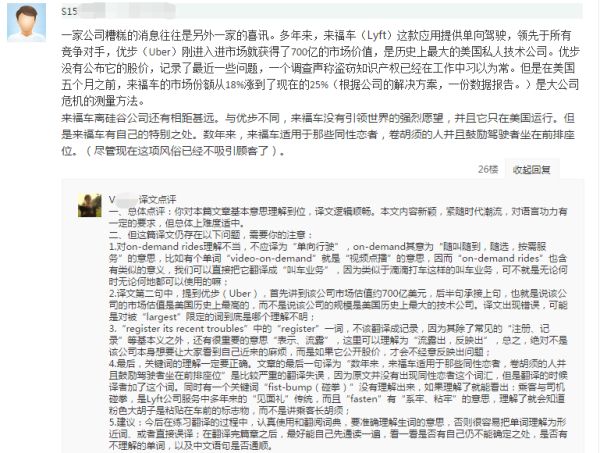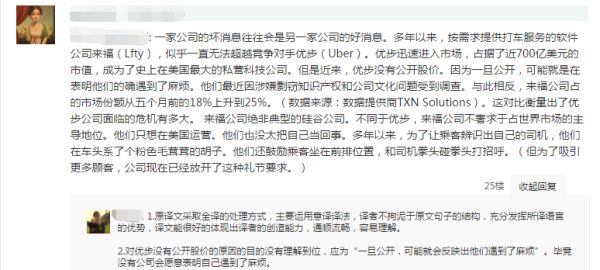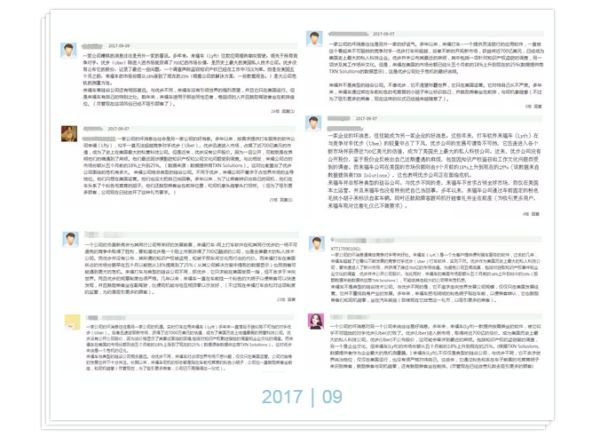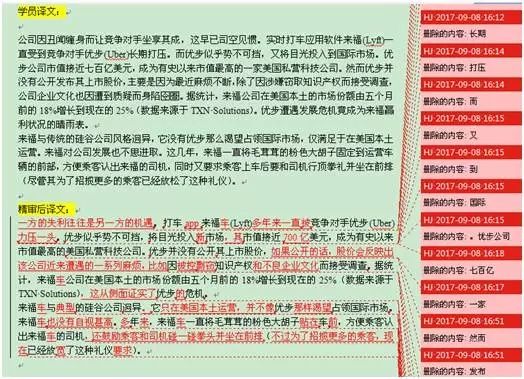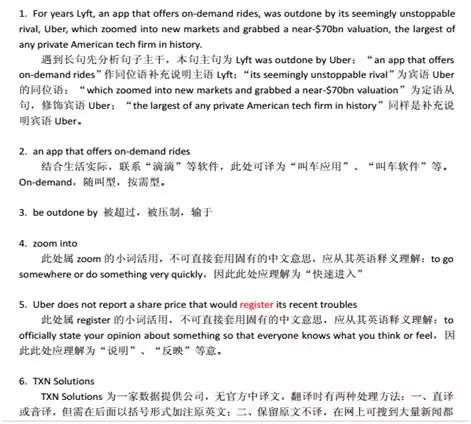Ride-hailing(网约车) wars
America’s number two ride-hailing firm hasbenefited from(得益于) Uber’s struggles
ONE firm’s bad news is often another’s good fortune.(观点句) For years Lyft, an app that offers on-demand rides, wasoutdoneby its seemingly unstoppable rival, Uber, which[ zoomed ]into new markets and grabbed a near-$70bn valuation, the largest of any private American tech firm in history. Uber does not report a share price that would[register ]its recent troubles, which include one investigation into allegedintellectual-property(知识产权) theft and another into its workplace culture. But that Lyft’s market share in America has risen from 18% five months ago to 25% now (according to TXN Solutions, a data provider) is a[ gauge ]of the larger firm’s crisis.
一方的失利往往是另一方的机遇。打车app来福车(Lyft)多年来一直被竞争对手优步(Uber)力压一头。优步似乎势不可挡,将目光投入新市场,其市值接近700亿美元,成为有史以来市值最高的美国私营科技公司。优步并没有公开其上市股价,如果公开的话,股价会反映出该公司近来遭遇的一系列麻烦,比如因被控剽窃知识产权和不良企业文化而接受调查。据统计,来福车公司在美国本土的市场份额由五个月前的18%增长到现在的25%(数据来源于TXN Solutions),这从侧面证实了优步的危机。
Lyft is far from a typicalSilicon Valley(硅谷) company. Unlike Uber, it does notlust for(贪求) world domination and it operates only in America. Nor does it take itself especially seriously. For years it identified its drivers by pink, fuzzy moustaches fastened to the front of cars, and encouraged riders tofist-bump(碰拳) their drivers and sit in the front seat (though it has now relaxed thisetiquette(n. 礼仪) to attract more customers).
来福车与典型的硅谷公司迥异。它只在美国本土运营,并不像优步那样渴望占领国际市场。来福车也没有自视甚高。多年来,来福车一直将毛茸茸的粉色大胡子贴在车前,方便乘客认出来福车的司机,还鼓励乘客和司机碰一碰拳头并坐在前排(不过为了招揽更多的乘客,现在已经放宽了这种礼仪要求)。
Its founders, Logan Green and John Zimmer, put an early emphasis on being nice to drivers, for example by allowing people to tip through the app. Many in Silicon Valleyviewedsuchcuddly(adj. 逗人喜爱的) behaviouras a sign thatUber wouldtrounce(v. 打败) it. The two do not just compete for passengers; each also tries to[ woo ]the other’s drivers. In 2014 Uber’s boss, Travis Kalanick, attempted to buy Lyft.
But Lyft’s culture hasturned out tobe an asset. Uber’s controversies, including Mr Kalanick being caught on videoberating(v. 严责) a driver, have helped its rival—particularly on America’sliberal-minded(adj. 思想开明的) west coast, where people are moresqueamish(adj. 易生气的,挑剔的) about using a brand associated withsexism(n. 性别歧视). Half of those who haveswitched toLyft in America say that company reputation wasthe chief reason(主因), says Survey Monkey, an online-polling firm.
On June 6th Uber said it had fired 20 employees after the conclusion of aninvestigation(n. 调查) intosexual harassment(性骚扰) (the result of a broaderprobe(n. 调查), led by a formerattorney-general(司法部长), is due soon). Oneventure capitalist(风险资本家) who has[backed](adj. 财力支持的) Uber says he is embarrassed to be seen getting into its cars.It seems nocoincidencethat(句型,并非偶然) in April Lyft said it had raised another $600m from investors, valuing the firm at $7.5bn, arounda third more than(分数表达) its previous mark.
That also reflects a change of mind among investors over the ride-hailing business. Having thought of it as awinner-takes-all(赢者通吃,胜者为王) market, in which one big company has a near-monopoly(n. 垄断) in each country, plenty now believepeople will spend enough on transport for more than one player to prosper(观点句). Mr Zimmer, Lyft’s co-founder, compares ride-hailing to thewireless-carrier(无线通讯) market, in which several companies boast high-quality coverage and plenty of customers.
Offering good “coverage” in ride-hailing so that rides can arrive within a few minutes, of course, requires resources. “We’re at the stage of building cell towers. That’s expensive,” says Brian Roberts, Lyft’s chief financial officer. But it may help the firm that it remains geographically and strategically focused. It has fewerdistractions(n. 分心,分散) than Uber, whichin addition to[除...之外(还有,也)] expanding globally ispushing into(推进,推动) new business lines, likefood delivery(送餐) and trucking.
Lyft’s strategy onself-driving(自驾) cars is alsodistinctive(adj. 与众不同的). Uber is investing heavily to build its ownautonomous(adj. 自主的) technology,guarding againstthe chance that(句型,以防) another service couldcome inwithout drivers andundercutit on price. But Lyft has opened up its network to other firms, including Waymo, a self-driving car unit that is Google’s sister company (and which has accused Uber of stealing trade secrets).
Collaborating withothers is better than buildingexpertisein-house(观点句), Lyftreckons(v. 认为), because so much uncertainty surrounds theevolution(n. 进化,发展,演变) of autonomous technology. In June Lyft announced another relationship, with an autonomous-driving startup called nuTonomy, which will start testing cars in Boston.There is a risk that(句型,有风险) Waymo and other partners may try to perfect their own self-driving technology with Lyft’s data and then launch a competing ride-hailing network, butthat seems a distant possibility(句型,可能性不大).
In theimmediate future(不远的将来) Lyft may find it harder to keepdifferentiatingitself.(观点句) Uber hasmimicked(v. 模仿) some of its successfultactics(n. 策略), such as tipping, and isoverhauling(v. 翻修,彻底检查) its culture. Many ride-hailing drivers now work for both services, which means travelling in a Lyft car is no longerunique(adj. 独特的).
The fact that Lyft has won a quarter of the American market could help both firms’ profits. In 2016 it lost around $600m and Uber $2.8bn. They formerly seemed likely to spend money fighting to the point of “mutually assureddestruction”, says Vincent Letteri of KKR, an investment firm that recently put cash into Lyft (afterdeclining tojoin in two previous funding rounds). Uber now accepts that Lyft is there to stay; it will have torein in(控制,约束,止住) promotional spending if it wants to achieve healthy profits in America to pay for expansion abroad and toreassurenervous investors, says Mr Letteri. Lyft will have less need to spend heavily onsubsidiesfor drivers and riders. It has stopped its practice of offering new customers $50 in free trips to sign up.Lyft still wants to be nice, but has no wish to betaken for a ride(被骗,当冤大头)(观点句).
看完这篇阅读笔记大家是否收获满满?但外刊学习的脚步可不能止步于此,要想深入学习,准确拿下一篇外刊文章,看看我们是怎么做的:
首先,我们会对本章做概述导读,先掌握文章主旨与大意,然后结合导图,开始阅读全篇原文。
然后,便是外刊共学的重头戏——精选片段进行翻译,小试身手,在翻译的过程中深入剖析句子,准确掌握句意和词汇。
经过第一轮的原文通读,再结合老师提供的练习词汇表,我们对翻译段落有了初步了解,遇到不确定的地方也可在群中讨论,寻求解答,然后就进行自主翻译,提交译文。
我们也可以看到其他学员提交的译文,经过一番对比,我们就可以发现别人的闪光点,相互借鉴彼此的长处,也会不时发现其他译文的弊端,告诫自己要避免犯同类错误。以人为镜,可以明得失。同时,老师也会选出几篇优秀译文供我们赏析,投票选出自己喜欢的译文,最终选出的优秀译文还可以得到译审老师的精改。看到老师改过的译文后我们才知道,好翻译,是改出来的,本就优秀的译文在精改之后焕然一新,相比之下,更能反映自己翻译的不足。
只看译文来学习翻译也是远远不够的,对于练习中的知识点及长难句,老师会在我们提交译文后发布解析,对练习中的难句进行分析,解释重点词汇与词组,必要时,还有背景知识简介,帮助我们综合掌握知识。
在老师系统的组织和学友们共同的帮助下,使学员对本篇文章有了更深入的了解,不仅仅只是阅读外刊,还参与了翻译练习,真正吃透其中的语言点,受益匪浅。
分享了这么多学习经验,大家是否也都蠢蠢欲动了呢?那就快快加入我们这个大集体吧!我们就是来自译国译民翻译米的“外刊共学群”小分队,在这里,有共同学习的学员,还有组织答疑的老师。现在共学群要正式纳新啦!9月25日起随时都可加入我们,共同学习外刊,学习英语,备战考试,放眼看世界,世界看中国,我们在外刊共学群等你。
报名方式
报名地址:http://www.fanyi.me/m/dcm/96186038
共学成果
欢迎围观外刊共学成果哦~
工作日每日更新链接:http://www.fanyi.me/snsgroup.htm?id=b1113ce2-28b5-481c-a8da-5be786e346fa



